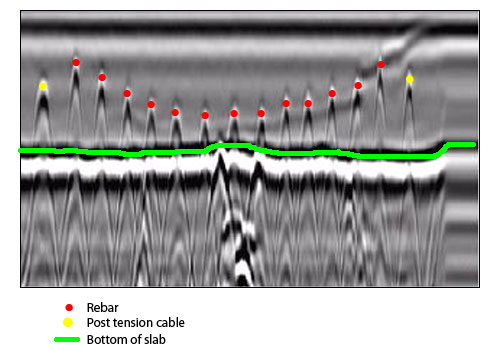Elevate Your Construction Process With the Strategic Insights of Concrete Scanning for Boosted Productivity
In the world of modern building and construction practices, the pursuit for effectiveness and accuracy is critical. Welcoming innovative innovations has ended up being a keystone for accomplishing these objectives. One such technology that has transformed the construction industry is concrete scanning. By harnessing the calculated insights given by concrete scanning, construction experts can unlock a realm of boosted productivity and streamlined procedures. The effects of incorporating concrete scanning go much past surface-level benefits, supplying a profound influence on job results.

Benefits of Concrete Scanning
Enhancing task performance and security, concrete scanning uses a non-destructive method for spotting covert objects within concrete frameworks. By using technologies such as ground-penetrating radar (GPR) and concrete x-ray imaging, building groups can properly find rebar, post-tension wires, electrical conduits, and various other obstructions before boring, cutting, or coring into concrete.
The benefits of concrete scanning are various. Building websites can be complicated settings, and recognizing what lies below the surface area can protect against injuries and accidents.
In addition, concrete scanning promotes total project effectiveness by avoiding and streamlining process rework. By determining potential issues early, teams can change their strategies proactively, saving time and resources in the lengthy run. Basically, the adoption of concrete scanning technologies is a critical financial investment that pays rewards in terms of productivity, safety, and cost-effectiveness.
Innovation Integration for Efficiency
Concrete scanning's capability to simplify process and enhance job performance can be additional maximized through tactical combination of advanced modern technologies. By including Structure Details Modeling (BIM) software program into concrete scanning procedures, construction teams can achieve a greater level of precision and control. Additionally, the integration of Enhanced Truth (AR) technology with concrete scanning can improve on-site visualization, enabling job supervisors and workers to overlay electronic information onto the physical atmosphere in genuine time.
Avoiding Costly Mistakes
Just how can precise interest to detail during concrete scanning procedures help building and construction teams in protecting against costly mistakes? Concrete scanning plays a critical role in recognizing prospective problems prior to they intensify into pricey errors. By using innovative scanning modern technologies such as Ground Permeating Radar (GPR) and electro-magnetic induction, construction groups can properly find rebar, energies, voids, and other obstructions within concrete structures. This level of accuracy makes it possible for project managers to make educated decisions pertaining to the format and design of their construction strategies, minimizing the risk of accidental damage to important infrastructure throughout the building procedure. Additionally, concrete scanning helps in making certain architectural integrity by determining weaknesses or issues in the concrete beforehand, allowing for prompt fixings and alterations. By proactively dealing with these issues, construction groups can stay clear of expensive mistakes such as rework, delays, or security hazards that may arise from ignored disparities in the concrete framework. Eventually, buying comprehensive concrete scanning treatments proves to be a cost-efficient strategy in the lengthy run, saving both time and sources while enhancing overall project effectiveness and quality. this page
Enhancing Task Management
Meticulous focus to information throughout concrete scanning processes not just helps in preventing expensive mistakes yet likewise lays a strong foundation for effective job administration in construction ventures. By including concrete scanning innovation right into job monitoring strategies, construction teams can simplify workflows, boost interaction, and make sure that tasks remain on track.
Concrete scanning supplies useful understandings right into the architectural honesty of existing components, permitting task managers to make educated decisions concerning design modifications or construction sequences. This aggressive strategy decreases the threat of unanticipated hold-ups or remodel, eventually saving time and sources. Furthermore, the data obtained informative post from concrete scanning can be incorporated into Building Information Modeling (BIM) systems, enabling real-time collaboration and coordination amongst various stakeholders.
Moreover, concrete scanning assists project supervisors determine prospective dangers or challenges prior to they intensify into bigger concerns, advertising a much safer work environment for all entailed. With improved visibility and accuracy offered by concrete scanning technology, task managers can efficiently plan, keep track of, and carry out construction tasks with higher efficiency and self-confidence.
Maximizing Performance
To boost efficiency in building and construction tasks, executing reliable strategies and utilizing advanced technologies is critical. Optimizing efficiency involves improving procedures, enhancing source allowance, and reducing downtime. One vital element of maximizing efficiency is via the fostering of concrete scanning innovation. By utilizing ground-penetrating radar (GPR) and other scanning techniques, building groups can precisely situate rebar, conduits, and other subsurface components, minimizing the danger of costly errors and delays throughout excavation and exploration.
Moreover, welcoming Structure Information Modeling (BIM) software can substantially boost productivity by developing detailed 3D designs that improve project visualization and sychronisation amongst various trades. BIM allows for better clash detection, allowing problems to be determined and settled prior to construction even begins, conserving time and resources in the future.
Implementing a lean building strategy, which concentrates on removing waste and maximizing performance throughout all job stages, is one more effective technique for making best use of efficiency. By promoting partnership, communication, and continuous improvement, building and construction groups can function much more cohesively towards achieving task objectives in a structured and productive way.
Final Thought
To conclude, the tactical implementation of concrete scanning in the building and construction procedure uses numerous advantages, consisting of enhanced efficiency, price financial savings, improved task management, and enhanced performance. By incorporating this innovation, construction groups can prevent pricey mistakes, streamline their procedures, and maximize their total job outcome. Concrete scanning is an important device that can raise the construction see process and bring about even more successful and successful outcomes.
